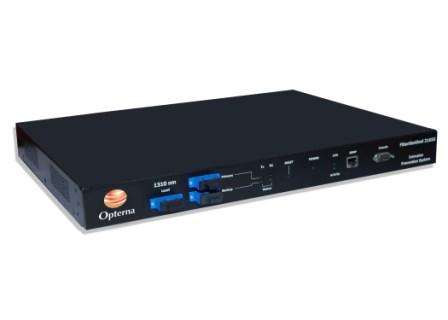cable, vdsl, patch
| Fiber Optic Security- Fiber Network Security-Homeland Defense- National Security-Fiber Optic Security Systems- Defense Department Security Systems-Fiber Optic Intrusion Prevention Systems-Opterna Fiber Sentinel System-Fiber Sentinel
Opterna’s Fiber Sentinel System uses WaveSense TechnologyTM to monitor such optical anomalies and provides continuous, real-time, protocol independent physical layer monitoring of a fiber optic communication system. It detects any signal variations (including tapping or signal injections), shuts down instantly and isolates affected path in milliseconds, re-routes the traffic to a back-up fiber path (which will also be monitored) and notifies the network administrator.
More Information On this article: LINK
American Data Supply, a registered CCR contracting supply company has teamed up with Opterna and several other leading fiber optic manufacturers to offer our national defense fiber optic security systems including any defense department or government entity a fiber optic intrusion prevention system called the Fiber Sentinel that will help prevent hackers or malicious intruders to break into our national defense using fiber optic technologies. The Fiber Sentinel will help prevent hackers or any malicious intruder to break into our national defense using fiber optic technologies. It can be shown that an intruder can easily tap a fiber without being detected.Readily available network test gear enables the non-invasive tapping and monitoring of fiber optic data streams. Opterna's breakthrough FiberSentinel System,with its exclusive WaveSense intrusion prevention technology, provides continuous, real-time monitoring of a fiber connection, detects any physical intrusions, and instantly eliminates the intrusion by shutting down the transmission. Automatic optical bypass switching simultaneously diverts data to an alternate fiber path. After detecting the intrusion, Fiber Sentinel denies access to the intruder, simultaneously re-routes legitimate traffic to a backup fiber path and then notifies the network operator of the intrusion. The system, which has no known competitor, provides continuous, real-time monitoring of the network connections without any disruption of the data stream, said Cohen. Fiber Sentinel identifies such intrusions as Trojan Horses, worms, denial-of-service attacks and other hacking attempts, he said. “The system shuts down the hacker’s path in milliseconds.” The company recently completed a proof-of-concept study for the Fiber Sentinel system, and has had favorable reviews from the military users, Cohen said. “Our target markets are embassies, financial services communities, air traffic controllers, the Defense Department, Border Patrol and the White House Communication Agency.” Other potential customers are companies concerned about industrial espionage, he said.
The world is becoming one global community where it is possible contact with one another through the use computer and the Internet. Keeping in touch with a loved one who is in a far away place or in the other side of the planet, right at the comfort of your home was never thought possible until today. With the increasing number of people traveling through the information highways or the cyberspace one thing is made necessary to keep and to provide oneself with, security. Infringement of ones security is becoming one big issue that has come to the consciousness of every American who is willing to defend his or her security. Violation of ones security is so pervasive that it happens anywhere even in those fiber optic data transmission dependent technologies, thus fiber optics security system, is selling like hotcakes in the U.S. market. More and more companies are finding ways to create a foolproof fiber optic technology in transmitting data to almost any part of the world. National security is at stake if highly organized group whose ideology is to topple a country down has intruded the Intelligence network of ones nation, thus crippling the economy and other vital pillars of the country. This concern calls for an efficient fiber optics security system. Large multinational corporations are always on the lookout for fresher and more technologically advanced fiber optics security system in order to protect the company from the intrusion of other competitors that hacks into their fiber optics powered installations. Any fiber optic expert can intercept data transmitted into fiber optics pathway, by intruding into fiber optics lines without getting noticed. Plenum Innerduct and Opterna have championed the cause in providing possible solution to fiber optic data transmission line intrusion. It has successfully invented what they call Fiber Sentinel, a system that will disable any hacker to get into the fiber optic system of an organization. The concept at play is that the Fiber Sentinel system guards the organizations data transmission center from hackers or intruders, once the hacker is detected, the system will automatically reroute the hackers path away from the transmission line. After it is done the system will then notify that an intruder has been denied access.
Call (866) 342-3721 Or Click On The Chat Button At The Top Of The Page To Talk To One Of Our Representatives
" Don't Gamble With Quality- Buy American " Visit this link for sample pricing Click For Fiber Optic Panel Pricing
Call (866) 342-3721 Or Click On The Chat Button At The Top Of The Page To Talk To One Of Our Representatives
- 2012 All RIghts Reserved - |

 The Fiber Sentinel is a Proven State Of The Art Hardware and Firmware Based 100% Fiber Optic Security Network Monitoring System Which is Tailored and Ideal For A Mulitude Of Uses And Locations:
The Fiber Sentinel is a Proven State Of The Art Hardware and Firmware Based 100% Fiber Optic Security Network Monitoring System Which is Tailored and Ideal For A Mulitude Of Uses And Locations:









